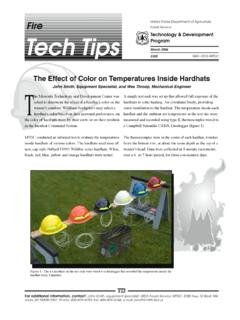Transcription of Early 20th-Century Building Materials: Siding and Roofing
1 United States Department of Agriculture Facilities Forest Service Technology & Development Program February 2008. 7300 0873 2308 MTDC. Early 20th-Century Building Materials: Siding and Roofing Richa Wilson, Intermountain Regional Architectural Historian Kathleen Snodgrass, Project Leader T. T. his tech tip is the fourth in a series about innovative build- ing materials developed in the availability of wood Building materials, greatly influenced the exterior appearance of the agency's first administrative and recreation facilities. Roofs were covered with wood first half of the 20th century and shingles or shakes. Many Early Forest Service buildings were commonly incorporated into Forest Service buildings.
2 The constructed from logs. Wood Siding with a variety of profiles series will help you identify materials by describing their his- was the usual cladding on buildings constructed with wood tories, manufacture, and physical characteristics. This series frames (figure 1). also addresses common problems and provides guidance on maintenance, repair, and replacement. As noted in the tech tip Early 20th-Century Building Materials: Introduction ( mlpubs/htm06732314/ Username t-d, Password t-d), the Forest Service always has encouraged the use of wood-based products in its facilities. This policy, combined with local materials Some Roofing and Siding 20th-centur y com monly used on Early s are no longer Forest Service Building for m or used or have changed in composition.
3 S tech tip, you Using information in thi Figure 1 Following national trends, the Forest Service often used wood g, asbestos- can identify asphalt roofin Siding with a variety of profiles on frame buildings in the Early 20th ing , and metal century. The drop Siding on this barn was one of the most popular choices. cement Roofing and sid The barn was built in 1933 at the Salmon Ranger Station in Salmon, ID. and rep air Siding . Maintenance (Salmon-Challis National Forest, Intermountain Region). inc lud ed. techniques also are By the 1930s, other materials sometimes were used for facility exteriors. In the Pacific Southwest Region, asbestos shingles and composition shingles were specified for some standard Building plans.
4 In contrast, the Washington Office's Principles of Architectural Planning for Forest Service For additional information, contact: Richa Wilson, author; USDA Forest Service, Intermountain Region, 324 25th Street, Ogden, UT 84401. Phone: 801 625 5704; fax: 801 625 5229: e-mail: 1. Administrative Improvements (1938) noted that composi- Aggregate pressed into the mats increased durability. tion Roofing was acceptable only on temporary structures. After 1900, stone granules replaced cinders as the aggregate After World War II, the Forest Service increasingly procured of choice. Colors were limited to black and shades of red and asphalt- and asbestos-based Building materials.
5 From a prac- green until the 1930s when manufacturers began using ce- tical standpoint, these products were desirable for their af- ramic granules. These granules offered a wider range of col- fordability, ease of installation, and resistance to fire, rot, and ors that could be combined to create a variegated appearance. insects. They reinforced a modern, progressive image as the Many homeowners chose to modernize their houses by Forest Service entered the second half of the 20th century. covering existing wood-shingled roofs with asphalt shingles. This tech tip focuses on Roofing and Siding materi- The asphalt shingles, valued for their fire resistance and als commonly used on Early 20th-Century Forest Service lower cost, came in numerous colors, patterns, and shapes.
6 Buildings materials that are either no longer used or have Often they were characterized by the method of installation: changed significantly in form or composition. The tech American method, French method, or interlocking. tip supplements information in the tech tips Overview of American method or "straight" shingles of the 1920s Roofing Materials for Forest Service Facilities (http://www. and 1930s were square or rectangular. The shingles were Username: t-d, installed to overlap the course below. They could be Password: t-d) and Overview of Siding Materials for Forest straight laid, abutting adjacent shingles, or Dutch lap, Service Facilities ( overlapping adjacent shingles (figure 2).)
7 Htm00712308/ Username: t-d, Password: t-d). 11 . Asphalt Roofing The American composition Roofing industry emerged in 7 16 . the 1840s, and by the 1880s it was flourishing. Asphalt-im- pregnated fibers with or without aggregate (such as cinders) 8 . pressed into the exposed surface were packaged for Roofing as long strips on rolls. A shift from roll Roofing to hand-cut Straight Laid asphalt shingles began in 1903. The asphalt Roofing industry grew during World War I because asphalt shingles were easy Prevailing wind to transport and were made from materials that weren't in short supply during the war. 3 . The popularity of asphalt Roofing grew in the 1920s, due in part to the National Board of Fire Underwriters' cam- 13 13 3.
8 Paign to eliminate wood-shingled roofs. The introduction of asbestos reinforcement further enhanced fire-resistance and 16 . strength. Consumers appreciated the variety of machine-cut shingle shapes and sizes. 16 . Dutch Lap The asphalt-saturated mats of Early Roofing were made of cotton or wool fibers known as rag felt. By the Early 1940s, the Roofing industry relied more on paper or wood fi- Figure 2 This drawing shows typical sizes, shapes, and installation for American method asphalt shingle Roofing . bers reinforced with asbestos fibers. Manufacturers switched to inorganic mats made of fiberglass in the late 1970s as con- cerns over asbestos increased.
9 2. French method shingles are shaped like diamonds or hexagons in an attempt to imitate slate roofs of French 21". chateaux. Historically, they were so large (12 by 12. inches and 16 by 16 inches were standard sizes) that they required storm anchors (hooks to hold the edges 24". down during high winds). Because they had little overlap on their edges, French method shingles provided only one layer of Roofing . This was acceptable when they were installed over existing Roofing , but not in new construction as the French method provided only minimal protection of the roof deck (figure 3). Figure 4 This drawing shows typical sizes, shapes, and installation for.
10 Interlocking asphalt shingles. 12.. 12. 36 . 12 . Three-Tab Asphalt Shingles 1 .. 1. 2. 9. 2. 9. 36 . 12 . Figure 3 This drawing shows typical sizes, shapes, and installation for French method asphalt shingles. Hexagonal Asphalt Shingles Interlocking shingles, whether installed in strips or Figure 5 This drawing shows typical sizes, shapes, and installation for as individual shingles, have high wind resistance and tab-style asphalt shingles. protect the roof decking better than other types. They were available by the late 1920s and were popular during the 1930s and 1940s. The complex shapes had Identification ears, catches, and slits that interconnected with the Most people can identify asphalt Roofing because of its shingle course below to create a basket weave pattern.













